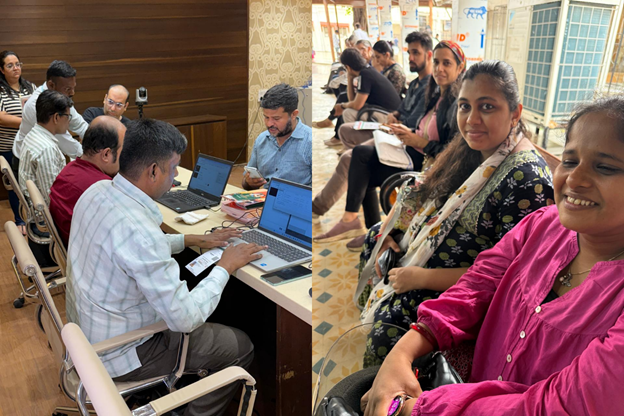Government Reinforces Support for Parsis Through Jiyo Parsi Biometric Drive
The drive was overseen by Shri Alok Kumar Verma, Deputy Director General, Ministry of Minority Affairs, and attended by senior officials from both the Ministry and the Government of Maharashtra.

- Country:
- India
In a significant move aimed at preserving the legacy and lineage of the Parsi community, the Ministry of Minority Affairs successfully conducted a one-day biometric authentication drive for beneficiaries of its flagship Jiyo Parsi scheme in Mumbai today. The initiative underscores the government’s commitment to addressing the demographic challenges faced by the community and ensuring that welfare benefits are delivered with transparency and efficiency.
High-Level Participation and Community Engagement
The drive was overseen by Shri Alok Kumar Verma, Deputy Director General, Ministry of Minority Affairs, and attended by senior officials from both the Ministry and the Government of Maharashtra. Key stakeholders from the Bombay Parsi Panchayat—India’s oldest and largest Parsi representative body—were also present, lending strong institutional support to the programme.
The event was held at a central location in Mumbai, the city with the highest concentration of Parsis globally. Of the 148 registered beneficiaries in the city, nearly 100 attended and completed their annual biometric verification, which is a prerequisite for continued receipt of benefits under the scheme.
The Jiyo Parsi Scheme: A Three-Pillar Approach
Launched in 2013, the Jiyo Parsi scheme is a specialized population stabilization and welfare initiative designed to arrest the declining numbers of Parsis in India. The community, known for its rich cultural heritage and contributions to India’s industry, arts, and public life, has been experiencing a steady population decrease due to late marriages, infertility, and low birth rates.
The scheme is structured around three foundational components:
1. Medical Assistance
This arm provides substantial financial support for fertility interventions. Beneficiaries can access aid for IVF (In-Vitro Fertilization), ICSI (Intracytoplasmic Sperm Injection), surrogacy, and post-conception care. The goal is to make advanced reproductive health services accessible to Parsi couples struggling with infertility, thus addressing one of the root causes of the population decline.
2. Health of the Community
This segment delivers monthly financial assistance to Parsi families with children, as well as to elderly dependents. It aims to ease the financial burden of caregiving and encourage younger Parsis to consider early family formation.
3. Advocacy
Under this component, the Ministry conducts awareness campaigns that promote early marriage, family planning, and fertility education. Community workshops, counseling services, and social outreach help normalize conversations around these often-sensitive issues within the Parsi context.
Drive Outcome and Future Outlook
The biometric authentication initiative in Mumbai was not only a compliance exercise but also served as a platform for feedback and real-time interaction between beneficiaries and policymakers. Several recipients shared testimonials on how the scheme has helped them start families, care for elders, or become more informed about reproductive health.
Importantly, the Ministry revealed that 138 new applications have been received for enrollment under the scheme. These are currently under evaluation, indicating that the programme is expanding its reach and relevance.
Shri Verma reaffirmed the government’s focus on making the scheme more accessible:
“The Jiyo Parsi scheme reflects our belief that every community, regardless of size, plays a crucial role in the fabric of India. We are committed to ensuring that Parsis receive all the support necessary to thrive and grow.”
A Critical Intervention for a Small but Influential Community
With fewer than 57,000 Parsis in India according to the last census—and projections indicating further shrinkage—Jiyo Parsi is a strategic demographic initiative. The scheme also sets an example of how targeted, community-specific welfare can complement India’s larger socio-cultural diversity goals.
The government plans to hold similar biometric authentication drives in other cities such as Pune, Ahmedabad, and Navsari, where smaller Parsi populations reside. Digital tracking and integration with Aadhaar are also being considered to streamline benefits delivery and reporting mechanisms.
A Path Forward
Today’s biometric drive not only ensured compliance but also signaled a renewed commitment to one of India’s most iconic communities. Through sustained outreach, advocacy, and inclusive policy frameworks, the government aims to reverse the demographic decline and celebrate the Parsi community’s contributions to India’s pluralistic heritage.
ALSO READ
Iyer’s Falcons Soar to T20 Mumbai League Final, Set to Face Maratha Royals
Police Officer Faces Corruption Charges in Navi Mumbai
Tragedy in Navi Mumbai: Casteist Slurs Lead to Student's Suicide
Maharashtra's Unified Transit Dream: A Seamless Ride for Mumbai Commuters
Ashwin Sheth Group's Bold Move in Mumbai's Luxurious Housing Market










